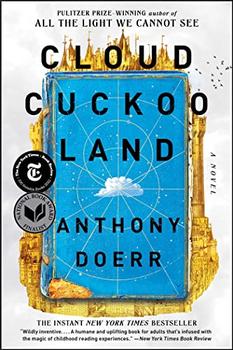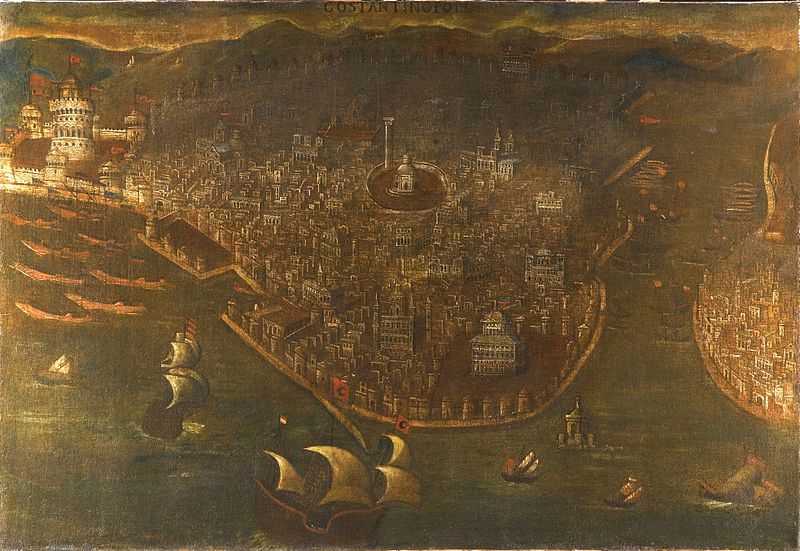Summary | Excerpt | Reading Guide | Reviews | Beyond the Book | Read-Alikes | Genres & Themes | Author Bio

A Novel
by Anthony DoerrThis article relates to Cloud Cuckoo Land
 Parts of Anthony Doerr's novel Cloud Cuckoo Land take place during the Fall of Constantinople in 1453 CE. Constantinople (now known as Istanbul) had long been an important trading hub by the time it was officially established by Roman emperor Constantine the Great in 330 CE. The ruler moved his government to the city, and it consequently became the capital of the Byzantine Empire and the center of Christianity — a position it held for a millennium. By the 15th century, however, both the city and the empire were in decline; schism had weakened the church, warring among European powers had caused fragmentation of the empire, and plague had killed off much of the population. Still, Constantinople was looked on as the last bastion between Christian Europe and the Muslim Ottoman Empire.
Parts of Anthony Doerr's novel Cloud Cuckoo Land take place during the Fall of Constantinople in 1453 CE. Constantinople (now known as Istanbul) had long been an important trading hub by the time it was officially established by Roman emperor Constantine the Great in 330 CE. The ruler moved his government to the city, and it consequently became the capital of the Byzantine Empire and the center of Christianity — a position it held for a millennium. By the 15th century, however, both the city and the empire were in decline; schism had weakened the church, warring among European powers had caused fragmentation of the empire, and plague had killed off much of the population. Still, Constantinople was looked on as the last bastion between Christian Europe and the Muslim Ottoman Empire.
The city had been the object of fighting throughout the centuries, but it survived siege after siege primarily because of its Theodosian Walls protecting its western side from land attacks. Built during the reign of Emperor Theodosius II (408-450 CE), these defenses were recognized as the most formidable protection throughout Europe and were thought to be impregnable. Any attacking army had to first get across a moat (around 60 feet wide and 20 feet deep), then scale several increasingly high walls, the last of which was about 40 feet tall and 15 feet thick. The walls were arranged so that defenders could stand on a platform and fire downwards on any advancing forces. As of 1453 CE, they had only been breached once, by knights of the Fourth Crusade in 1204 CE, but this was because a door had been left open and not because the defenses themselves had failed. Constantinople was similarly protected from ocean attack by an impressive sea wall, parts of which were 20 feet tall, as well as a chain that could be stretched across the waterway, blocking access to the city from the Bosporus, a body of water that runs between the Sea of Marmara and the Black Sea.
19-year-old Mehmed II became the seventh sultan of the Ottoman Empire in 1451, and he began making preparations to attack Constantinople almost immediately. The Byzantine emperor, Constantine XI, realized a siege was imminent and began appealing to his neighbors for help, but received little support. Hungary, the major power in the area at the time, had already negotiated peace with the Ottoman Empire; Pope Nicholas V saw Constantine's weakness as an opportunity to force a reconciliation between the Roman Catholic church and the Eastern Orthodox church; and other European states were occupied with their own problems and had few resources to spare. Constantine was convinced, however, that the walls would withstand any attack, and that once European rulers saw the threat they would come to the city's aid.
Mehmed's strategy was a simple but effective one: Completely seal off the city, and then bombard the walls until they fell. To this end, he deployed gunpower on an unprecedented scale. He had about 70 cannons constructed, the largest of which was about 30 feet long with a mouth about three feet in diameter, capable of firing an 1100-pound ball over half a mile. To take control of the city's waters, he built a ramp that allowed him to portage vessels around the chain blocking the Bosporus. His force of 60,000-80,000 men on the ground, along with a fleet of around 30 warships and over 100 smaller craft, began the attack on Constantinople on April 6, 1453. The walls began failing almost immediately against the cannons, but the citizens repaired them, defending the openings and keeping them small so no invading forces could gain access.
On May 29, 1453, Mehmed launched a massive assault that eventually allowed a force of Janissaries — elite infantry units — to gain access to the city. In the process, Constantine was killed, and a rout ensued. Mehmed rode in triumph to the Hagia Sophia, the largest cathedral in all Christendom at the time, and declared the edifice would henceforth be a mosque, renaming it Ayasofya.
Many European powers were shocked and horrified by the Fall of Constantinople, but had little power or will to do much about it. Pope Nicholas V tried to convince others to mount a crusade to retake the city, but died before his efforts could come to fruition. Constantinople remained under Ottoman control until the Empire itself was dissolved by treaty in 1922 following its defeat in World War I. From the ashes arose modern day Turkey. In 1930 the city changed its name to Istanbul (derived from the Greek for "to the city"), which had been in informal use since at least the 10th century.
Painting of the Fall of Constantinople by unknown artist, late 15th to early 16th century
Filed under People, Eras & Events
![]() This "beyond the book article" relates to Cloud Cuckoo Land. It originally ran in October 2021 and has been updated for the
September 2022 paperback edition.
Go to magazine.
This "beyond the book article" relates to Cloud Cuckoo Land. It originally ran in October 2021 and has been updated for the
September 2022 paperback edition.
Go to magazine.






Your guide toexceptional books
BookBrowse seeks out and recommends the best in contemporary fiction and nonfiction—books that not only engage and entertain but also deepen our understanding of ourselves and the world around us.